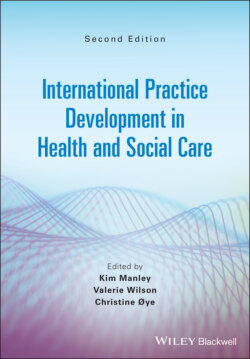Читать книгу International Practice Development in Health and Social Care - Группа авторов - Страница 15
Practice development: its relevance to contemporary health and social care and crisis
ОглавлениеPD is about our individual and collective practice as health and social care practitioners in any setting. Our purpose based on what matters to people has at its heart relationships with individuals, people and communities based on a shared set of values and visions about how we work together and with those experiencing care.
However, most health and social care is provided in teams and increasingly across complex systems, where workplace culture and contexts are recognised as powerful influencers on how care is experienced by both recipients and providers. Social norms reflect the values considered to be important (either implicitly or explicitly) and through the culture experienced impact how we work and learn together.
Workplace culture influences whether assumptions are challenged, learning and shared goals are implemented, aspirations are fulfilled, and subsequently whether valued staff are retained and health outcomes achieved.
Prerequisites to achieving good workplace cultures include leadership and facilitation expertise anchored in the values that enable collective approaches built on shared direction and purpose. These prerequisites are integral to PD and for this reason, a collaborative PD journey often begins by exploring and agreeing key values ‘up front’.
A growing evidence base through PD research together with a commitment to knowledge translation has helped us to understand not just what strategies work, why they work and for whom they work (Wilson and McCormack 2006), but also how to engage people and how to embed and sustain learning and evaluation in the workplace (Dewing 2010).
The knowledge base derived from practice‐based research with people in different contexts is particularly important as frontline practitioners across all settings (individual homes, care homes, communities and hospitals) are risking their lives in relation to COVID‐19 to provide care that is not just safe but that courageously keeps people at the heart of care, both recipients and team colleagues.
The pandemic has tested the key values and person‐centred approaches championed and facilitated through PD about how we communicate. The use of protective clothing inevitably dehumanises our humanness through detracting from showing that the person we are communicating with is a unique person. Because of muffled verbal and non‐verbal communication, the message that the person is at the heart of our purpose can be lost. We have all been heartened by the innovative ways and sheer persistence in overcoming these physical barriers when committed to human values by those who care. This recognises the tremendous burden on practitioners and carers and the need for practitioners to be supported and treated in a person‐centred way too.
The notable cohesion and interprofessional teamwork that have resulted from a shared purpose and direction during the pandemic have also required total community collaboration. Powerful impact is demonstrated when people genuinely work together, breaking down the professional silos and barriers that often hinder effective collaboration.
Teams which have already learned to work together with shared values and visions will be more prepared for crisis situations, such as COVID‐19, to find effective person‐centred ways of working despite challenges experienced and ‘top‐down’ instructions. Practice developers in teams work with contextual barriers to find promising ways despite challenges, by co‐creating ways of working for innovative solutions.
The pandemic has generated a crisis in how we work together. PD theory draws on the work of Bryan Fay (1987) to understand the nature of crisis informed through critical social science to explain how such challenges can lead to creative innovations that inform both future systems and ways of working. Fay’s theory itself has been revised to capture the creativity generated through PD research (McCormack and Titchen 2006).
Creativity in response to crisis has already resulted in dramatic increases in virtual ways of working and communication supported by technology. With family members not able to be at the bedside of seriously ill relatives, technology has connected people to those important to them. Telemedicine is replacing the resource‐intensive provision of outpatient follow‐up clinics; previously perceived barriers are being recognised as assumptions, enabling them to be dismantled to free up more people‐orientated ways of working. Different teams and partners are connecting virtually to enable prompt decision‐making and action, with seismic shifts in genuine interprofessional working and learning. COVID‐19 has freed us from the taken‐for‐granted assumptions around innovations, to cut through red tape and implement new policies, procedures and practices.
It is timely to recognise in this pandemic year that it is also the year of the nurse and midwife, and that nursing has upheld the values of person‐centred, compassionate care and safety over the past century. This has particularly come to the fore in the current crisis, where it has been recognised widely and publicly that these values are important to society.
